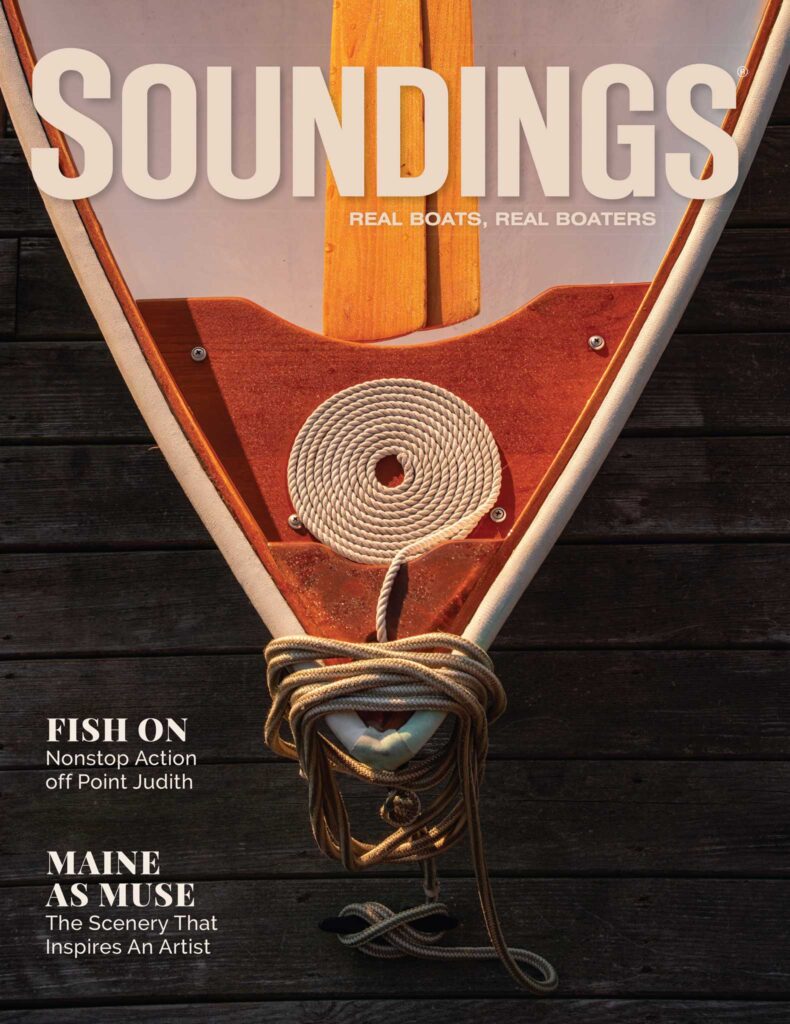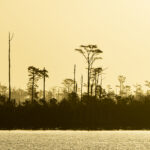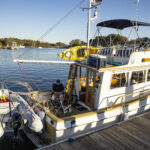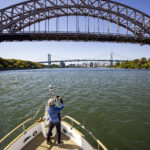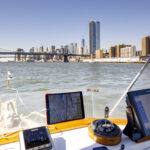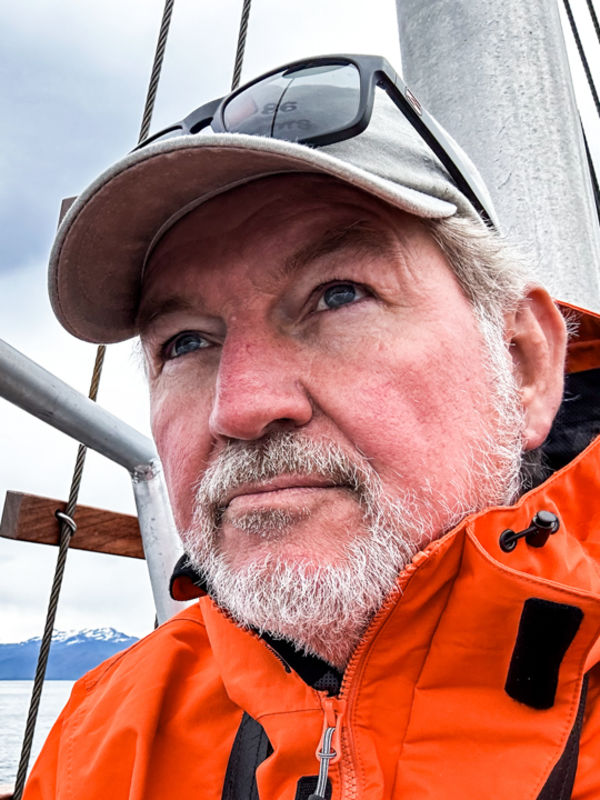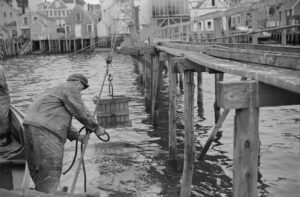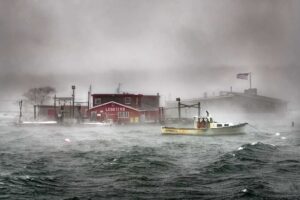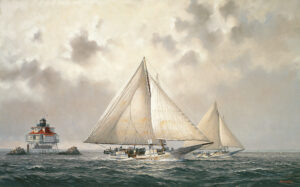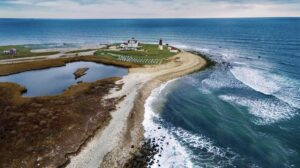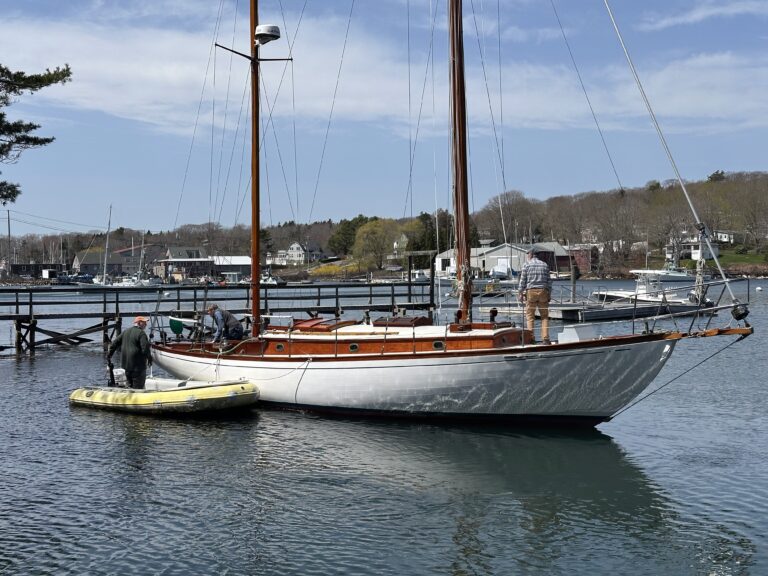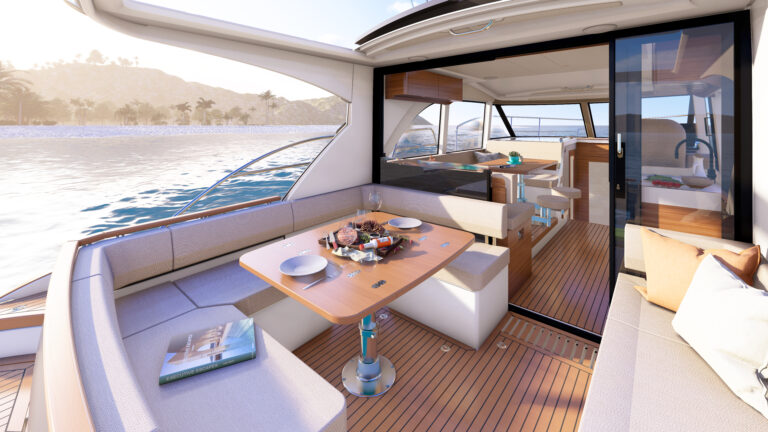It didn’t take long for the meatballs to make it to the flybridge.
Before Tenley van der Wal disembarked from Snow Goose in Jersey City, New Jersey, she told her husband, Onne, and me to eat out of the fridge before we dove into the pantry or went out to dinner. Less than an hour later, as Onne and I motored the Van der Wal’s 1986 Grand Banks 32 underneath the Verrazano-Narrows Bridge, Onne asked me if I wanted to have gehaktballen voor ontbijt. Onne and I were both born in the Netherlands and since the Dutch love meatballs, I told him I would be more than happy to have them for breakfast.
Within minutes, the leftover meatballs, accompanied by a mayonnaise-based dipping sauce, came up from the galley and disappeared into our stomachs. If there’s one condiment the Dutch love, it’s mayonnaise. To the dismay of most Americans, we put copious amounts of it on our French fries and with a little ketchup mixed in, a mayo dipping sauce is a lovely way to down some cold leftover meatballs.
Five days prior, the Van der Wals had departed their homeport of Jamestown, Rhode Island, and enjoyed near perfect weather as they’d begun their maiden voyage to the Bahamas. They overnighted at Safe Harbor marinas in Mystic and Branford, Connecticut, and Port Washington, New York, before making it to New York City. When Tenley had to return to Jamestown to take care of some business, I had hopped aboard to help get Snow Goose to Annapolis, Maryland.

For me, a slow cruise down the Jersey Shore would be a blast from the past. Before moving to Maine three years ago, I had lived there for almost 45 of my 60 years. In the early 1980s, on weekends, Sandy Hook’s Horseshoe Cove was where my brother and I anchored his 1968 Pearson Lark sailboat. Off Seabright, in 1978, in a single feeding frenzy at the Shrewsbury Rocks, I caught so many weakfish and bluefish that I was informed I should never bother to go fishing again. During college summers, I partied at Donovan’s Reef on the Seabright seawall, and in 1995, my wife and I saw Bruce Springsteen play a raucous set at the Tradewinds night club. Just behind Seabright, which sits on a barrier beach, was Fair Haven where my wife and I lived for two decades, sailed on the Navesink River and raised our two children.
For about an hour, I bored Onne witless about my life on the Jersey Shore, until I spotted a humpback whale off Belmar. When it resurfaced 50 feet behind us with a loud puff of air, it felt like a privilege to have seen it.
We had planned to enter the New Jersey Intracoastal Waterway at Manasquan Inlet and run down it from beginning to end, but when we got to that inlet before 2 p.m., we decided to continue to Barnegat Inlet, 25 miles down the coast. To sustain us, Onne fried us some eggs. With the meatballs gone, eggs—another Dutch dietary staple—would become our everyday breakfast.
Near Seaside Park we spotted another whale, but something was amiss. Its left fluke had been almost completely severed. We could see the bloody flesh and the humpback was struggling to get its blowholes above the surface. It was fighting for its life, but there was nothing we could do to help. We reported it to the Marine Mammal Stranding Center in Brigantine and within minutes, USCG Base Philadelphia called us to see if we had witnessed the whale getting struck. We hadn’t, and knowing there was nothing else we could do we continued southward. Looking back at our wake, the whale’s tail never rose from the water again. It had been a heartbreaking scene. The first whale sighting had made us high, but this one brought us low.

After entering Barnegat Inlet, we pulled into Lighthouse Marina where we poured ourselves a drink and Onne cooked us a tasty meal with the chicken that Tenley had told us needed to be consumed first. We’d covered 60 miles at about 8 knots. Not bad for a little displacement trawler.
We were off the dock at sunrise. We wanted to make as much progress toward Cape May while the going was good because the forecast predicted sloppier conditions in the afternoon.
As I was driving us out of the inlet between the jetties, I noticed that a channel marker on the Navionics app was in the wrong spot while the AquaMaps software on Onne’s iPad had the green can in the right spot. As we neared the ocean, lots of approach cans were showing on the AquaMaps app, but some of the actual buoys were missing. Onne switched the Raymarine display to its Lighthouse software to see what buoys that app showed, but it was missing four of the five outer buoys. It was a reminder to always compare what you see in front of you to what’s on your navigational screens or paper charts and to question everything. Later in the day, after we entered the New Jersey ICW, we would be reminded of that again.
Barely back in the ocean, we spotted a third humpback. For the next two hours we cruised about a mile off Long Beach
Island, passing its uninterrupted line of million-dollar mansions, only punctuated by the water towers of the various towns and villages. I had seen it all before. I met my wife on LBI almost 30 years ago, but Onne was amazed at how people had built up the shoreline. It was a stark contrast to undeveloped Island Beach State Park on the Barnegat Peninsula, which we’d passed the day before and probably still looked the way it did before John Cabot, Giovanni da Verrazzano and Henry Hudson, or even Leif Ericson, had sailed by it.
We enjoyed our fried egg breakfast on the flybridge, spotted two more whales off to starboard and encountered a large pod of porpoises. When Onne thought he saw some false albacores on the surface, he dragged his South African fishing rig through them to see if we could land ourselves some fresh protein. By now, we were both stunned by the amount and variety of marine life we’d encountered. In almost 45 years in New Jersey I had only seen one whale, and now in a 24-hour span, we’d seen five whales, too many porpoises to count, and a wide variety of fish and birds, including brown pelicans and gannets.
Before we got to Absecon Inlet, where we planned to get on the ICW, Onne saw a notice to mariners that the Route 30 bascule bridge behind Atlantic City had been put in the fixed position for a longterm construction project. Even though the wind was building up and a swell was forming, rather than lower Goose’s mast to get under that bridge, we opted to do another hour on the ocean and enter the ICW near Ocean City at Great Egg Harbor Inlet. There we encountered a strong opposing current and within minutes of entering the ICW, almost ran aground. A track on Onne’s GPS that he got from a friend told us to go one way, while AquaMaps told us to go another. When Onne noticed that the water beneath our keel was getting skinnier he slowed down and we were able to reverse just as the prop started kicking up silt. We got back in the channel, which had somehow shifted to the other side of the waterway, and chastened by our near grounding became hyper-focused on the depthfinder.

The scenery was typical New Jersey. There were short stretches of great beauty mixed in with some of the worst-looking sprawl the world has to offer. One minute we were in beautiful wetlands with herons, egrets and bald eagles and the next we were passing row after row of identical, non-descript, vinyl-clad homes that looked so low to the water it seemed they might soon be swallowed by the rising seas.
For lunch, Onne appeared on the flybridge with plates of crackers covered with ham, cheese and salmon, all lubricated with the perfect touch of mayo.
At ICW marker 386 we spotted an Albin 36 DC high and dry on the right side of the channel. Onne raised the Albin on the VHF and her skipper, who seemed unperturbed by his grounding, advised us to call the dredge operator who was working about 30 feet to his port side. After multiple unanswered calls, the dredge operator finally stepped out of his little house and waved us through. Onne glued Snow Goose to the left side of the channel, cleared the green buoy by inches and the dredge by mere feet, and slipped us through as the depthsounder showed 3 feet, even though the Goose drew 3 feet, 8 inches. Because the tide would continue to fall for the next two hours, we decided we’d had enough skinny-water adventures for one day. Since we hadn’t gambled in Atlantic City’s casinos, we saw no need to gamble on the water.
Having covered another 60 miles, we tied off at the Yacht Club of Stone Harbor, where I dug sausages, cauliflower, cucumbers and mushrooms out of the fridge. I gave them all the Dutch treatment—vinegar and salt for the cucumbers and lots of butter on everything else—and we packed it in for the night.
The next morning, we topped off with diesel at the Stone Harbor Marina but when Onne saw the price per gallon was $6.28 he decided to only put enough into the two tanks to get us to Cape May with a reserve. “Heel duur,” he said to me in Dutch in front of the attendant who we were pretty certain wouldn’t have a clue that Onne had just called his fuel really expensive.
Approaching the last bridge before entering the lock in the Dismal Swamp Canal
Sunrise fishermen
Typical ICW scenery just south of the Dismal Swamp Canal
Tenley unties the tender to head back to Snow Goose from the dinghy dock in Oriental
Sunrise over the Chesapeake City bridge from Snow Goose’s flybridge heading towards the Chesapeake Bay and Annapolis
Pelicans and Cormorants waiting for a meal in the fish traps on the Chesapeake off of Smith Island, Virginia.
The Goose tied up with Soundings executive editor Pim van Hemmen at work
Sunrise from Snow Goose in Chesapeake City, Maryland
Cormorants in take off!
Snow Goose about to go under one of several bridges as she runs down the East river towards NYC
Navigation gear on the flybridge of Snow Goose as she heads south on the East river alongside Manhattan
The red and white navigation mark #NH on Long Island Sound at sunrise
We requested three bridge openings on our way to Cape May. As we approached the Two Mile Bridge, I told Onne about a guy who had once passed under the bridge, spotted a red channel marker far off to starboard, hit the throttle as he made a hard right, and ripped the bottom out of his boat on the shallows. After passing under the bridge, Onne took us straight ahead to the correct buoy and into the Cape May Canal. Fifteen minutes later we pulled up at Utsch’s Marina’s fuel dock, where we filled up the tanks at a much more reasonable $5.18 per gallon and put Snow Goose in a slip.
When I returned to the boat after a hot shower in one of Utsch’s capacious and well-outfitted private bathrooms, Onne was frying up some eggs for a late breakfast. Tenley had done a good job with the provisioning, but she hadn’t counted on two Dutchmen blowing through the egg and mayo supply. We were out of eggs and low on the mayo. A resupply was in order.
That afternoon the rain came. We waited it out and went for dinner at the Lobster House, a Cape May institution right behind Utsch’s. Because there were no supermarkets nearby, we walked to a nearby Wawa convenience store and got the mayo and eggs.

At midnight, the forecasted wind arrived with a vengeance, almost immediately spiking to 40 knots. The noise was impressive, but just as quickly as the storm had begun, after 40 minutes of howling, it stopped just as suddenly.
The next morning, the marina was as still as a pond. By 8 a.m. we were in the Cape May Canal. When we reached Delaware Bay, we found 1- to 3-foot seas and about 12 knots of wind slightly off the starboard bow. The ride wasn’t bad, but when the weather kicked up and water started coming over the bow, we moved inside the cabin, where we entertained ourselves by playing with the Raymarine sonar. The Goose’s sidescan, 3D and other views showed tons of fish passing beneath our keel, and even though our speed wasn’t particularly great for putting out a line, we put it out anyway.
Within an hour, the seas calmed down and the sun came out. With the incoming tide we started making 8.5 knots over the ground, but then the autopilot started acting up. Onne suspected a loose wire, which later turned out to be true, but until we could sort it out, we steered by hand. I didn’t mind at all. I always found steering therapeutic and with the incoming tide we started moving at a steady 10 knots over the ground.
Onne repeated the ham, cheese and salmon on crackers routine for lunch and there were no complaints from the crew. There was plenty of mayo.
At the C&D canal entrance with the tide still favoring us, we decided to skip Delaware City, Delaware, and aim for Chesapeake City, Maryland, 20 miles down the canal. When we snagged the last open spot at the town dock, we celebrated our good fortune with a fist bump. We’d completed another 60-miler on what had turned into another beautiful day.
With the fridge now out of dinner ingredients and no supermarkets within striking distance of Onne’s collapsible bicycles, we enjoyed a great meal on the glass-enclosed porch of the Bayard House. The next day’s weather forecast, which predicted 20-knot winds for Chesapeake Bay, would mean we’d spend another night in Chesapeake City.
The next morning after tea, coffee and eggs we went to the local Dollar General, which was the only store we could easily reach by bicycle. When we got there, we were not surprised to find very slim pickings. It was a good thing our wives weren’t along. My wife would have been appalled if she knew we bought ham at a dollar store. I’m pretty sure Tenley wouldn’t have approved either.

Back in town, we honored the Chesapeake Bay by devouring some of its crabs at the Tap Room. When we learned that a dozen larges were priced at $90, our frugal Dutch side kicked in and we opted for a dozen smalls for $40. To fill our stomachs, we added boil and peel shrimp and an order of fries with lots of mayo on the side.
Onne and I spent the next hour joyfully ripping off legs, smashing claws, digging out bits of crabmeat from the carapaces and requesting more mayo for the fries. After we finished, we agreed that the crabs were super tasty, but that without the fries and shrimp we would have starved.
After a leisurely afternoon, we walked to the Chesapeake Inn’s The Deck for dinner where the music was too loud, too many old guys were chatting up women who were way too young for them and the Caesar salad and burger were just OK. We tried to make it to the ice cream shop before its 8:30 p.m. close, but when we walked up to it at 8:27 p.m. found that the lights were out. Regardless, Chesapeake City was a lovely destination that we both felt was well worth a repeat visit in the future.
We shoved off before sunrise and with a low-hanging fog over the water made a beeline for the Chesapeake Bay. The atmospheric conditions created a visual smorgasbord for Onne, who had a field day making photos while I drove.
By midday, Onne appeared on the flybridge with ham and avocado crackers. As we neared Annapolis, I had been reflecting on our lovely journey and the surprising variety of marine life we’d seen. But as I downed my lunch, I was in for one more surprise. Who knew avocado and mayo went so well together?
This article was originally published in the January 2023 issue.

